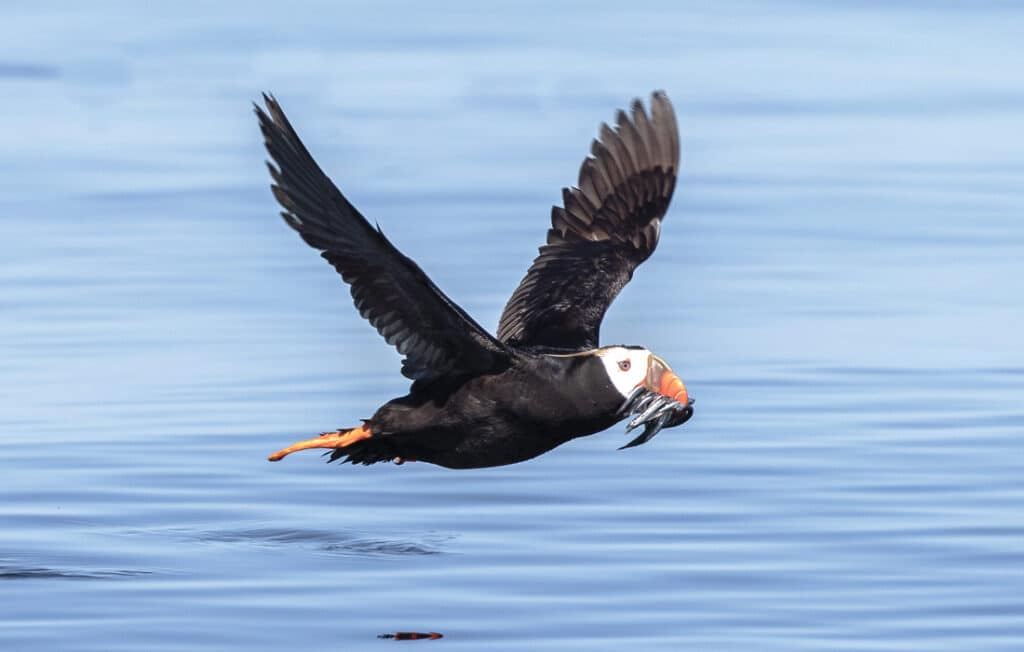
Tufted Puffins are the largest of the puffins and breed along the Pacific Rim from northern California to Alaska in North America, and Japan and Russia in Asia. They are named for the beautiful pale-yellow feather tufts on their heads during breeding season. They spend almost the entire year at sea, only coming to land to nest in burrows at cliff edges, on grassy slopes, or in rocky crevices. They lay one egg per pair and raise their chick, called a puffling, before making their way back to open water. A seabird in the auk family, their antics and appearance have earned them the nickname “clown of the sea.” But don’t be fooled by their circus-like waddle—these birds can dive up to 200 feet, fly up to 55 miles per hour, and catch and carry up to 20 fish crosswise in their uniquely grooved bill.
Tufted Puffin decline along the southern portion of their range is not fully understood, and the dramatic declines documented over such a short time span are truly perplexing. Warming ocean temperatures related to climate change and subsequent impacts to their forage fish prey base is thought to be one factor. In addition, pollution and invasive species, which can severely alter their breeding habitat, are likely additional stressors. The Tufted Puffin is listed as endangered in Washington State, sensitive in Oregon, and a species of special concern in California. In 2014, the species was petitioned for listing under the U.S. Endangered Species Act, and a subsequent assessment by the USFWS determined that listing was not warranted. The decision was in part based on the large number of puffins in Alaska, where, according to the USFWS, about 96% of the species breed and are relatively stable. But the outlook is different farther south, especially in Oregon.

Today, Three Arch Rocks in Tillamook County hosts the largest colony—about 40%—of Oregon’s remaining Tufted Puffin population. Farther north in Cannon Beach, Haystack Rock serves as one of the Northwest’s most accessible locations to observe puffins during breeding season, despite their declining population—from 312 birds counted in 1988 to 106 counted in 2023. Oregon is unique among Pacific states in that the federally protected Oregon Coast National Wildlife Refuge Complex covers almost all of the rocks, islands, and reefs off the coast where Tufted Puffins return each spring to breed—including Haystack Rock. Bird Alliance of Oregon’s (then Oregon Audubon Society) early work lobbying then President Theodore Roosevelt protected Three Arch Rocks in 1907 as the first wildlife refuge west of the Mississippi, and the protection has since been expanded to this larger refuge complex managed by USFWS. Established in 1935, the refuge complex hosts an estimated 1.3 million colonial nesting seabirds and thousands of marine mammals. The refuge complex includes 1,853 rocks, reefs, and islands and stretches from Tillamook Head south to the California border. All the islands of the refuge are designated national wilderness areas, with the exception of one-acre Tillamook Rock. This means that the Tufted Puffin breeding grounds fall under federal jurisdiction, and almost all conservation work must be done in coordination with USFWS. While scientists and federal land managers are working hard to better understand the decline of the Tufted Puffin, more must be done—and quickly—if we are to save this iconic bird.
In early January, 20 stakeholders representing Bird Alliance of Oregon, USFWS, Oregon Department of Fish and Wildlife, American Bird Conservancy, Friends of Haystack Rock, Oregon State University, Oikonos, National Audubon Society, and others met to talk about present and future priorities for Tufted Puffin conservation. The coordinated work now being developed will address the decline of the Tufted Puffin utilizing three interrelated strategies.
-
- The first strategy is focused on science and subsequent management actions: the coordination of on-the-ground actions that will—if successful—restore and maintain self-sustaining populations of Tufted Puffins within their historic range. The research and surveys being conducted by USFWS, Oregon State University, and others will continue, but we are also working to prioritize specific conservation actions that will include direct, hands-on activities like invasive species removal, social attraction (e.g., using decoys to attract Tufted Puffins to viable breeding grounds), placement of nest boxes, soil amendments, and appropriate management of predators.
- The second strategy will focus on using existing policies as well as advocating for stronger policies with the aim of leveraging the best regulatory tools to better protect the Tufted Puffin.
- Lastly, we will raise the profile of this iconic species’ plight through targeted outreach and engagement to build public support for Tufted Puffin conservation efforts.
The work won’t be easy, and we know we will learn valuable lessons along the way, but if we are to save the beloved Tufted Puffin, we must take immediate action.
Just 553 birds. We would love to reach a point where that number not only increases, but that there are so many Tufted Puffins at their historic breeding habitat that it is impossible to count all of them.



